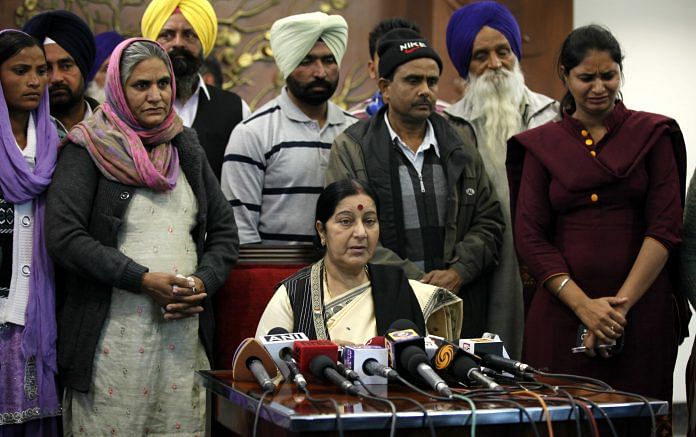After three years of maintaining that they were alive, external affairs minister Sushma Swaraj announced Tuesday that the 39 Indians missing in Iraq since 2014 were dead.
New Delhi: A group of 40 Indian men were kidnapped by the Islamic State (IS) terror group in Mosul four years ago, and 39 of them shot dead.
External affairs minister Sushma Swaraj announced Tuesday that the 39 Indians missing in Iraq since 2014 had died.
Only one, Harjit Masih, survived by playing dead and later escaped Mosul by pretending to be a Bangladeshi. His version of events was consistently denied by the government, which said it had at least “six sources” that claimed the 39 were alive.
Here is a timeline of the events as they happened:
2014
9 June: According to Masih and the families of the 39 other men, the group begin to call the Indian embassy in Baghdad for help on this day. One family member said the calls may have started on June 6.
10 June: IS seizes control of Mosul.
11 June: The 40 Indian workers are kidnapped. They call up their families, inform them about the situation.
13 June: Two of them call the Indian embassy in Baghdad. They are reportedly told to have “faith in God”, and that they couldn’t be “offered much help at the moment as the 700 km distance between Baghdad and Mosul is under lockdown”.
13 June: The ministry of external affairs (MEA) is officially informed that the group has been abducted.
15 June: The families of the men receive their last phone calls from them. Thirty-nine men are believed to have been lined up and shot dead by IS men.
16 June: A family member informs the press about the abduction.
18 June: The government makes a public statement. The MEA spokesperson, citing International Red Crescent and other sources, says 40 Indian workers “kidnapped”. The government says they haven’t received “ransom demands”.
22-23 June: Sole survivor Harjit Masih is met by Indian officials in Erbil.
July: Masih is brought to India, but kept under detention. According to him, he was first sent to Bengaluru for two months, where he trained to become an electrician, then kept at a detention centre in Greater Noida for months. He was sent home after being promised a job in Dharamshala in 10 days. After 10 days, he was asked to go to Dharamshala for a job, but to no avail. He returned home, and held a press conference soon thereafter.
27 November: Sushma Swaraj announces Masih is in the “protective care of the government”, and that she has six sources confirming the other 39 men are alive. She later says she has eight sources.
2015
14 May: Masih holds a press conference at the Mohali residence of AAP MP Bhagwant Mann, and announces the 39 men were killed by the IS.
May: Swaraj again says the 39 men are alive.
29 September: At a meeting in New York, PM Modi asks Palestinian President Mahmoud Abbas to pass on any information he receives about the men. Abbas says the prisoners are still alive.
2016
17 October: Iraqi forces, backed by a US-led coalition, launches an offensive to take Mosul back, the country’s biggest military campaign since the US forces left in 2011.
2017
11 March: Al-Hash al-Shaabi, or the ‘popular mobilisation forces’, announces it has found the remains of 500 prisoners executed by the IS in Badush prison.
16 June: The MEA says the 39 men are alive and unharmed, but no official demand has been made for their release.
9 July: The Iraqi government officially retakes Mosul after nearly nine months; no word about the 39 men.
16 July: MoS for external affairs, Gen. V.K. Singh (Retd), sends information from Iraq that the men are being held in Badush prison. Swaraj says she’ll get more information from the Iraqi foreign minister when he arrives in India.
22 July: The Badush prison, it is revealed, was demolished in June.
24 July: Iraq foreign minister Ibrahim al-Jafari arrives in India, says he’s not sure if the men are dead or alive.
26 July: Swaraj brings up the case in Parliament. “It is a sin to declare a person dead without concrete evidence. I will not do that sin,” she says.
27 July: Once again, Swaraj says she cannot declare the men dead until she has concrete evidence. Stating that she has reasons not to trust Masih, Swaraj says the family of one of the missing men, Nishan Singh, claims they spoke with him on 17 June, two days after the shooting. She maintains the group were taken to a jail, after which they worked in construction and then on a farm.
21 October: The government announces it is collecting DNA samples from the families of the missing men, and a team will take the samples to Iraq to aid in their search.
2018
20 March: Swaraj announces the 39 men are dead. Deep penetration radars were used to find and exhume the bodies in Badush. The DNA samples confirmed the identity of 38 bodies, while there was a 70 per cent match for the 39th. The mortal remains will be brought back to India soon.



